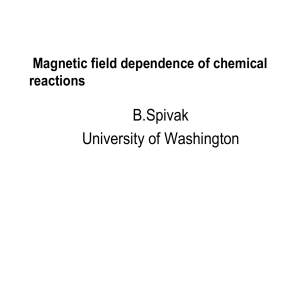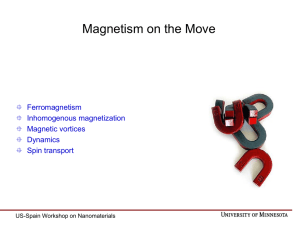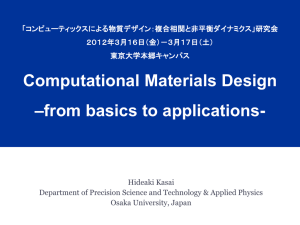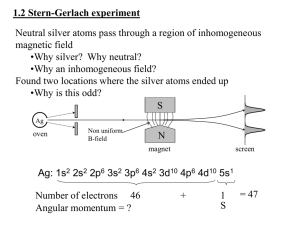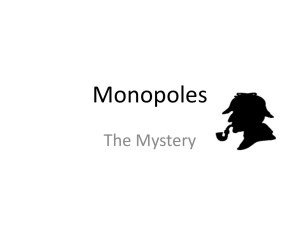Magnetic monopoles in spin ice
advertisement
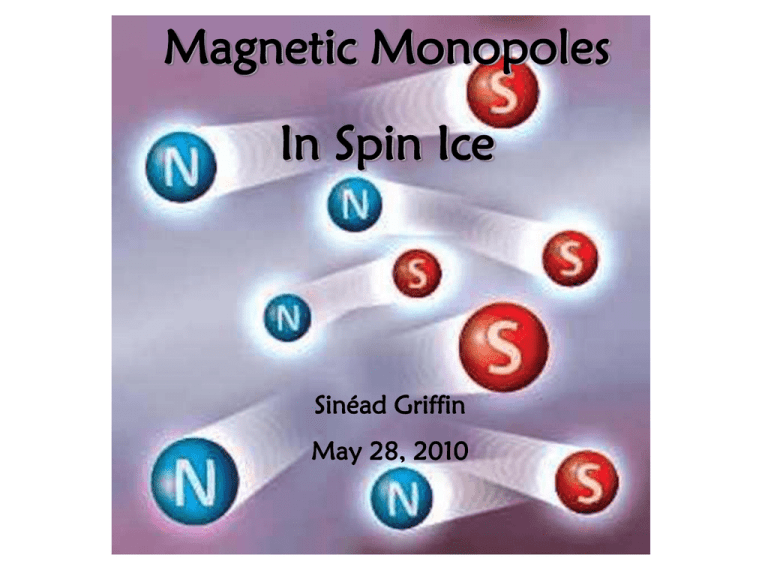
Magnetic Monopoles In Spin Ice Sinéad Griffin May 28, 2010 Magnetic Monopoles in Spin Ice • What are the features of these magnetic excitations? • How do the material properties cause them? Castelnovo et al (2008), Morris et al (2009) What are Magnetic Monopoles? Benjamin Franklin - electric fields caused by + and – charge - magnetic fields caused by N and S poles Maxwell - 1800s: link between magnetism and electricity - Maxwell’s Equations for Electromagnetism (1873): Without Monopoles Faraday - suggested idea of magnetic charges as a computational tool Jackson (1975), Maxwell (1873) What are Magnetic Monopoles? Benjamin Franklin - electric fields caused by + and – charge - magnetic fields caused by N and S poles Maxwell - 1800s: link between magnetism and electricity - Maxwell’s Equations for Electromagnetism (1873): Without Monopoles With Monopoles Faraday - suggested idea of magnetic charges as a computational tool Jackson (1975), Maxwell (1873) Magnetic Monopoles: A Physical Reality? Pierre Curie - first to suggest the existence of isolated magnetic monopoles Paul Dirac - firm theoretical grounding of magnetic monopoles in 1931 paper - quantization of electric charge is the result of the existence of isolated electric and magnetic charges. DIRAC MONOPOLE: A magnetic monopole is an isolated particle that acts as a source of a magnetic field (i.e. non-zero divergence). DIRAC STRING: Infinitely thin flux tubes that connect magnetic monopoles. Many Grand Unified Theories predict the existence of magnetic monopoles that were created in the beginning of the universe. Curie (1894), Dirac (1931), Polchinski (2003) Spin Ice Pyrochlores R2Ti2O7 or R2Sn2O7 R: rare earth with a large magnetic moment Bramwell & Gringas (2001) Spin Ice Pyrochlores R2Ti2O7 or R2Sn2O7 R: rare earth with a large magnetic moment Gd2Ti2O7 Phase transition to unusual long range order at 1K Tb2Ti2O7 Cooperative paramagnetic/ spin liquid Dy2Ti2O7 Spin Ice Ho2Ti2O7 Spin Ice Er2Ti2O7 Long range magnetic order Greedan (2005) Pyrochlore Lattice R2Ti2O7 → R2Ti2O6O’ Two sublattices: Ti2O6 R2O’ = Corner-sharing octahedra Corner-sharing tetrahedra Geometrical Frustration in Pyrochlores Geometric Frustration: Local ordering rules are incompatible with long-range ordering 2D Frustration: AFM ordering on a triangle 1/3 of spins frustrated 3D Frustration: FM ordering in tetrahedron (A2O’) ½ of spins frustrated Ising spin axis is along diamond bonds Snyder et al (2001) Ice Rules Phil Anderson pointed out a connection in 1956 Hydrogen Positions In Ice-Ih ↔ Magnetic Tetrahedra in Pyrochlores H2O R2O’ Wurtzite structure Pyrochlore sublattice Two H close, two H far Two spins in, two spins out Anderson (1956), Pauling (1945) Ground State Entropy at 0K Apply spin ice rules (two in, two out) to a 2D lattice Choice of which spins point in and which spins point out: - Degenerate ground state - Residual Entropy S=kBlnW W= 3/2 for Ice-Ih or spin ice. Giaque & Stout (1936) Creating Monopoles in Spin Ice T > 0K Thermal fluctuations cause disorder in the lattice Image from www.backreaction.blogspot.com Creating Monopoles in Spin Ice T > 0K Thermal fluctuations cause disorder in the lattice Some spins will flip Creating Monopoles in Spin Ice T > 0K Thermal fluctuations cause disorder in the lattice Some spins will flip Defect propagates through the lattice to preserve the ice rules Are these Dirac Monopoles/Strings? Packets of magnetic charge Separated by ‘string’ of flipped spins Move independently - don’t keep their partners - many ways of connecting a + and – Always occur in pairs Dipole model describes the interactions (not point charges, but oriented dipoles) Dirac string not infinitely thin, rather an observable flux tube Divergence is always zero So what are these magnetic excitations? - Not fundamental particles but emergent quasi-particles - Have many characteristics of isolated magnetic charges - Example of 3D fractionalization of magnetic charge Castelnovo et al (2008), Jaubert et al (2009) Uses for Quasi Magnetic Monopoles Bramwell et. al (2009), • Magnetricity: Magnetic quasiparticles are charge-like and have an associated current Influence of applying magnetic and electric fields • Model for understanding frustrated magnetic systems • Study of ground state degeneracy related to other systems such as protein folding and relaxor ferroelectrics References Magnetic monopoles in spin ice Nature 451 42 (2008) C. Castelnovo, R. Moessner & S. L. Sondhi Dirac Strings and Magnetic Monopoles in the Spin Ice Dy2Ti2O7 Science 326 411 (2009) D. J. P. Morris, D. A. Tennant, S. A. Grigera, B. Klemke, C. Castelnovo, R. Moessner, C. Czternasty, M. Meissner, K. C. Rule, J. U. Hoffmann, K. Kiefer, S. Gerischer, D. Slobinsky, R. S. Perry Classical Electrodynamics Wiley (1975) J. D. Jackson Sur la possibilité d’existence de la conductibilité magnétique et du magnétisme libre Séances de la Société Français de Physique, p 76 (1984) P. Curie Quantised singularities in the electromagnetic field Proc. R. Soc. A 133 60 (1931) P. A. M. Dirac Monopoles, Duality and String Theory hep-th/0304042 (2003) J. Polchinski Spin Ice State in Frustrated Magnetic Pyrochlore Materials Science 294 1495 (2001) S. T. Bramwell & M. J. P. Gringas Frustrated rare earth magnetism: Spin glasses, spin liquids and spin ices in pyrochlore oxides Journal of Alloys and Compounds 408-412 444 (2005) J. E. Greedan References How ‘spin ice’ freezes Nature 413 48 (2001) J. Snyder, J. S. Slusky, R. J. Cava & P. Schiffer Ordering and Antiferromagnetism in Ferrites Physical Review 102 4 1008 (1956) P. W. Anderson The Nature of the Chemical Bond Cornell Univ. Press, Ithaca, New York (1945) L. Pauling The entropy of water and the third law of thermodynamics The heat capacity of ice from 15K to 273K. J. Am. Chem. Soc. 58 1144 (1936) W. F. Giaque & J. W. Stout Signature of magnetic monopole and Dirac string dynamics in spin ice Nature Physics 5 258 (2009) L. D. C. Jaubert and P. C. W. Holdsworth Measurement of the charge and current of magnetic monopoles in spin ice Nature 461 956 (2009) S. T. Bramwell, S. R. Giblin, S. Calder, R. Aldus, D. Prabhakaran & T. Fennell

